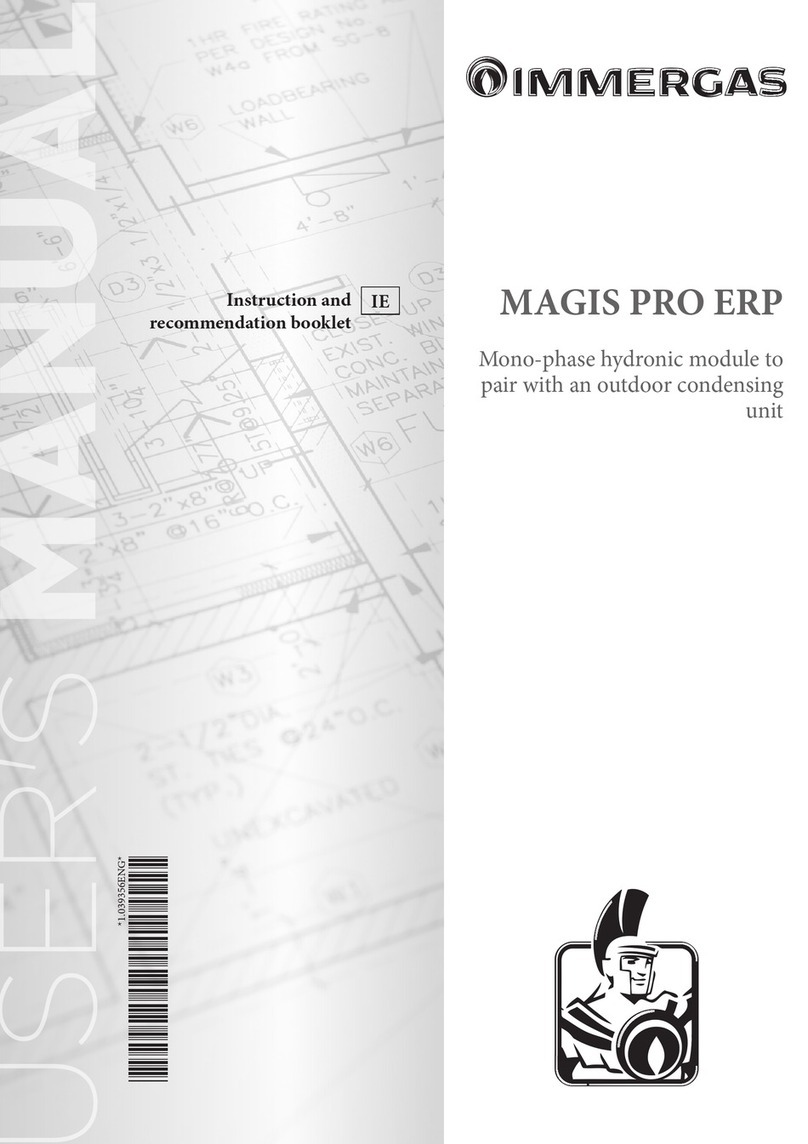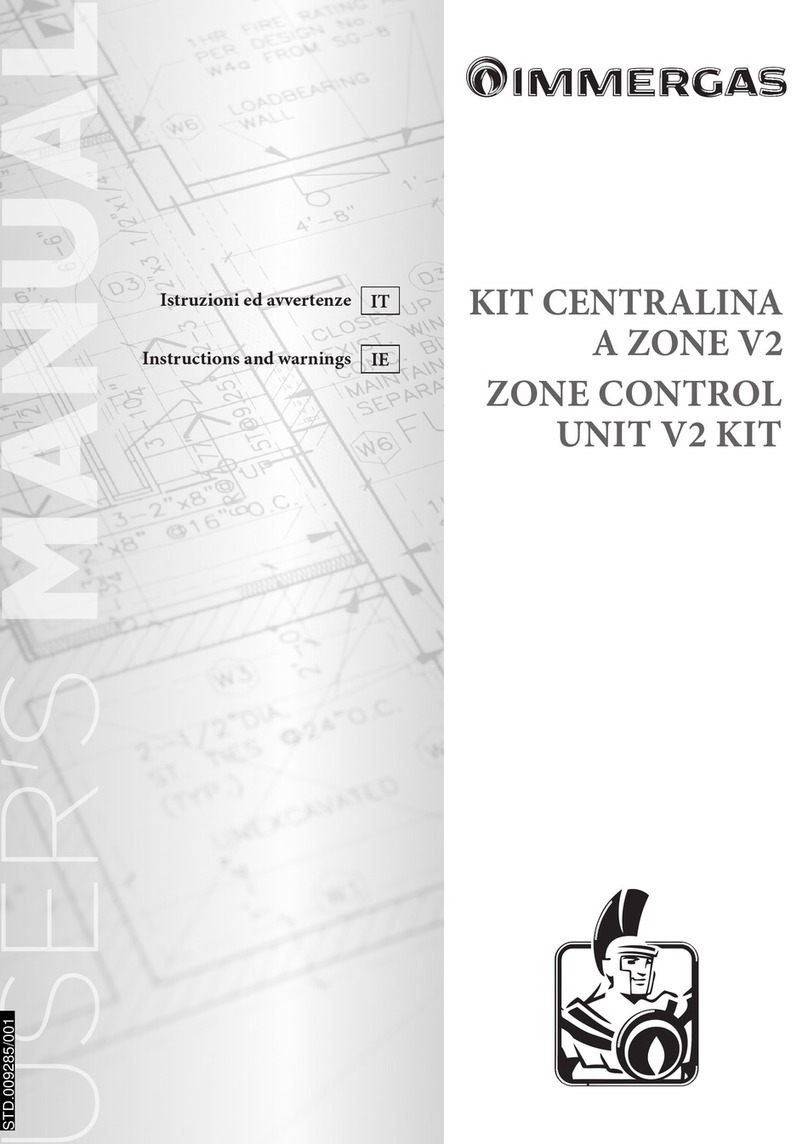
5
1-1
INSTALLERUSERMAINTENANCE TECHNICIAN
1HYDRONIC MODULE IN
STALLATION.
1.1 INSTALLATION
RECOMMENDATIONS.
e Magis Pro ErP hydronic module was de-
signed solely for wall mounted installation for
heating and air conditioning and to produce
domestic hot water for domestic use and similar
purposes.
In order to operate properly, it must be paired
with an Audax Pro condensing unit; as such, all
the provisions regarding the safety and use of
both appliances must be respected.
e place of installation of the appliance and
relative Immergas accessories must have suitable
features (technical and structural), such as to al-
low for (always in safe, ecient and comfortable
conditions):
- installation (according to the provisions of the
technical legislation and technical regulations);
- maintenance operations (including scheduled,
periodic, routine and special maintenance);
- removal (to outdoors in the place for loading
and transporting the appliances and compo-
nents) as well as their eventual replacement
with appliances and/or equivalent components.
e wall surface must be smooth, without any
protrusions or recesses enabling access to the
rear part. ey are not designed to be installed
on plinths or oors (Fig. 1-1).
Only professionally enabled companies are au-
thorised to install Immergas appliances.
Installation must be carried out according to the
provisions of the laws in force and in compliance
with local technical regulations and the required
technical procedures.
Before installing the appliance, ensure that it is
delivered in perfect condition; if in doubt, contact
the supplier immediately. Packing materials (sta-
ples, nails, plastic bags, polystyrene foam, etc.)
constitute a hazard and must be kept out of the
reach of children.
Should the appliance be contained inside or be-
tween pieces of furniture, there must be enough
space for routine maintenance; therefore, it is
recommendable to leave at least 3 cm between the
unit casing and the vertical walls of the furniture.
At least 25 cm of free space must be le above, in
order to be able to carry out maintenance and,
if necessary, install an additional resistance (op-
tional). Leave space under the hydronic module
to allow the hydraulic connections to be serviced.
Keep all ammable objects away from the ap-
pliance (paper, rags, plastic, polystyrene, etc.).
Do not put household appliances under the hy-
dronic module as they could be damaged if the
safety valve trips or if the hydraulic ttings leak.
Otherwise, the manufacturer cannot be held lia-
ble for any damage to the household appliances.
For the same reasons, it is also recommendable
not to put furnishings, furniture, etc. under the
hydronic module.
In the event of malfunctions, faults or incorrect
operation, turn the appliance o immediately
and contact an authorised company (e.g. the
Immergas Technical Assistance centre, which
has specically trained sta and original spare
parts). Do not attempt to modify or repair the
appliance alone.
Failure to comply with the above implies personal
responsibility and invalidates the warranty.
• Installation regulations:
- this hydronic module can be installed out-
doors in a partially protected area. By partial-
ly protected area, we mean one in which the
unit is not directly exposed to the elements
(rain, snow, hail, etc.).
- Installation is prohibited on the vertical
projection of cooking hobs.
- Installation is also prohibited in places/en-
vironments that constitute common parts of
oce condominiums such as stairs, cellars,
entrance halls, attics, los, escape routes,
etc. if they are not located inside technical
compartments under the responsibility of
each individual building and only accessible
to the user (for the features of the technical
compartments, see the technical standards in
force).
- Using specic kits, the hydronic module can
be paired with other Immergas products
and installed inside an outdoor wall using
the specic Solar Container recessed frame
or mounted on an indoor wall in the Domus
Container.
Attention: Installing the wall recessed frame
kit must guarantee the hydronic module sta-
ble, ecient support. e recessed frame kit
ensures appropriate support only if installed
correctly (according to the rules of good
practice), following the instructions on its
instructions leaet. e recessed frame for
the hydronic module is not a load-bearing
structure and cannot replace the removed
wall. erefore, correct positioning inside
the wall must be checked. For safety reasons
to prevent leaks, the compartment that will
house the hydronic module in the masonry
wall must be plastered.
Attention: installing the hydronic module
mounted on the wall must ensure the generator
itself stable, ecient support.
e dowels (standard supplied with the unit) must
only be used to secure the unit to the wall; they can
only ensure sucient support if inserted properly
(according to the rules of good practice) on walls
built with solid or semi-hollow bricks. In the
case of walls made from hollow brick or block,
partitions with limited static properties, or in any
case walls other than those indicated, a static test
must be carried out to ensure adequate support.
ese hydronic units are used to heat water to be-
low boiling temperature at atmospheric pressure.
ey must be connected to a central heating
system and domestic hot water circuit suited to
their performance and capacity.
Attention:e storage tank unit must also be
installed in an environment in which the tem-
perature cannot fall below 0°C.
"Anti-Legionella" treatment of the Immergas
storage tank (function enabled when there is
an additional electrical resistance for domestic
hot water). During this phase, the temperature
of the water inside the tank exceeds 60°C with
the subsequent risk of burns. Keep this domes-
tic water treatment under control (and inform
the users) to prevent unforeseeable damage
to people, animals, things. If required install a
thermostatic valve on the domestic hot water
outlet to prevent scalding.
YES NO































